-
Posts
814 -
Joined
-
Last visited
Content Type
Forums
Events
Store
Video Gallery
Posts posted by JulioHerrlein
-
-
-
Thanks, Stephane and Janusz !!
All the best !
Julio
-
Dear Friends !
This is the performance of the piece A.S. Mailbox at the Musmat Congress !
This piece was all done in Opusmodus (with some post editing in Musescore).
Happy to share this with you !
I have one more thing this week...
There are many great pieces in the concert ! (and also a Schoenberg Quartet) ! Enjoy
- Stephane Boussuge and opmo
-
 2
2
-
Congratulations, Stephane !!
Best !
-
Sorry, but I´m not the owner of this video...
But is already in this link:
https://youtu.be/RzPEORQNlZIBest !
-
Cool !!!
Thanks a lot !!!
Best !
-
Thanks, Janusz
Here is the breakdown of the equivalent permutations for the example
012 021 102 120 201 210
013 031 103 130 301 310
014 041 104 140 401 410
015 051 105 150 501 510
023 032 230 203 302 320
024 042 204 240 402 420
025 052 205 250 502 520
034 043 304 340 403 430
035 053 305 350 503 530
045 405 450 504 540 054
125 152 215 251 512 521
123 132 213 231 312 321
124 142 214 241 412 421
135 153 315 351 513 531
134 143 314 341 413 431
145 154 415 451 514 541
234 243 324 342 423 432
235 253 325 352 523 532
245 254 425 452 524 542
345 354 435 453 534 543The first column is the unique "seed" that gives the other permutations
Just the seeds
012
013
014
015
023
024
025
034
035
045
125
123
124
135
134
145
234
235
245
345Seeds above, arranged as complementary sets
012,345
013,245
014,235
015,234
023,145
024,135
025,134
034,125
035,124
045,123 -
According to the definition of the function:
COMBINATION will return a list of all the combinations N elements in length from a list.
There is something strange...
For example:
(combination 3 '(0 1 2)) gives
((0 1 2) (0 2 1) (1 0 2) (1 2 0) (2 0 1) (2 1 0))
and violate what the "unique combination" state you mentioned, since 0 1 2 is also (0 2 1)
Looks like permutation...
I´m looking for all n-permutations of a larger set, like
3 element permutations from a group of 6 elements (0 1 2 3 4 5).
Maybe having the possibility of choosing the cardinality of permutations...
Something like (permute 3 '(0 1 2 3 4 5)) should give the result I mentioned before (120 possbilities)
Best,
Julio
13 hours ago, JulioHerrlein said:012
013
014
015
021
023
024
025
031
032
034
035
041
042
043
045
051
052
053
054
105
102
103
104
125
120
123
124
135
130
132
134
145
140
142
143
154
150
152
153
204
205
201
203
214
215
210
213
234
235
230
231
243
245
240
241
253
254
250
251
302
304
305
301
312
314
315
310
321
324
325
320
341
342
345
340
351
352
354
350
401
402
403
405
410
412
413
415
420
421
423
425
430
431
432
435
450
451
452
453
504
501
502
503
514
510
512
513
524
520
521
523
534
530
531
532
543
540
541
542 -
Dear All,
Recently, I used the function combination and got some strange result
I did this
(combination 3 '(0 1 2 3 4 5))
I got this result - 60 combinations
(0 1 2) (0 1 3) (0 1 4) (0 1 5) (0 2 3) (0 2 4) (0 2 5) (0 3 4) (0 3 5) (0 4 5) (1 2 3) (1 2 4) (1 2 5) (1 3 4) (1 3 5) (1 4 5)(2 3 4) (2 3 5) (2 4 5) (3 4 5)(5 0 1) (5 0 2) (5 0 3) (5 0 4) (5 1 2) (5 1 3) (5 1 4) (5 2 3) (5 2 4) (5 3 4) ,(4 5 0) (4 5 1) (4 5 2) (4 5 3) (4 0 1) (4 0 2) (4 0 3) (4 1 2) (4 1 3) (4 2 3)(3 4 0) (3 4 1) (3 4 2) (3 5 0) (3 5 1) (3 5 2) (3 0 1) (3 0 2) (3 1 2) (2 3 0) (2 3 1) (2 4 0) (2 4 1) (2 5 0) (2 5 1) (2 0 1) (1 2 0) (1 3 0) (1 4 0) (1 5 0)
There is something I did not get ?
Best,
Julio
The expected result should be 6 x 5 x 4 = 120
Like this...
012
013
014
015
021
023
024
025
031
032
034
035
041
042
043
045
051
052
053
054
105
102
103
104
125
120
123
124
135
130
132
134
145
140
142
143
154
150
152
153
204
205
201
203
214
215
210
213
234
235
230
231
243
245
240
241
253
254
250
251
302
304
305
301
312
314
315
310
321
324
325
320
341
342
345
340
351
352
354
350
401
402
403
405
410
412
413
415
420
421
423
425
430
431
432
435
450
451
452
453
504
501
502
503
514
510
512
513
524
520
521
523
534
530
531
532
543
540
541
542 -
-
Great, Janusz !
Thanks !
-

Best !
Julio
-
Acccording to the book (p. 156), there is a missing b4...
Should be, like
(pitch-transpose 5 (trope-hexachord 43))
((f4 fs4gs4bb4c5d5) (g4a4b4cs5eb5 e5))
But there is a b4 missing
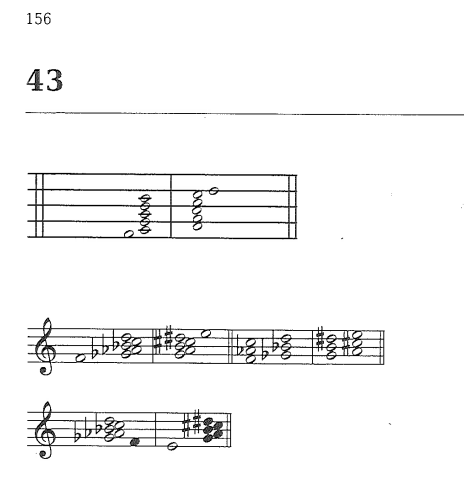
-
Another one !
Only 5 notes in TROPE 43 (second hexachord)
(trope-hexachord 43)
((c4 cs4eb4f4g4a4) (d4e4gs4bb4 b4))Yes, I´m researching Hauer now, for writing a paper !
Opusmodus is helping me a lot ! !
Best !
Julio
-
Dear All,
The second half of trope 21 is showing a note repetition.
(trope-hexachord 21)
((c4 b3 bb3 eb3g3a3) (d3fs3gs3 cs3f3 fs3))
The pitch-class fs3 appears twice, comprising a 5 note set (it should be an hexachord, a 6 note-set)
(d3fs3gs3 cs3f3 fs3))
According to Sedivy (2011, pg 134) the trope 21 is shown below:
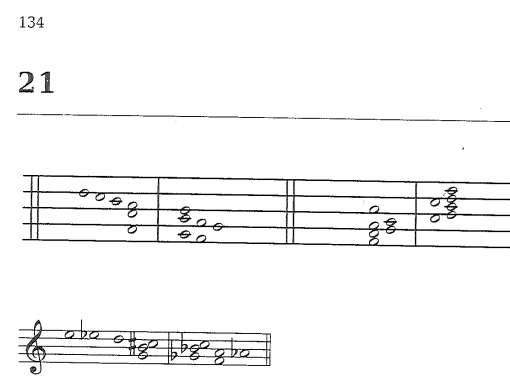
In Sedivy´s book, this trope are shown starting in E, thus
(pitch-transpose -8 (trope-hexachord 21)), thus
((e3 eb3 d3 g2b2cs3) (fs2bb2c3 f2a2 bb2))
There is a repetition of two Bb pitch classes in the second hexachord
(pitch-transpose -8 (melodize (last (trope-hexachord 21))))
((fs2 bb2 c3 f2 a2 bb2))
According to the book, the last note should be an Ab, not a Bb, like
((e3 eb3 d3 g2b2cs3) (fs2bb2c3 f2a2 ab2))
All the best !
Julio
-
Nice improvisational effect !
Best !
-
-
Dear All,
I´m looking for a way to plot some graphs like these, showing 12 tone row ordering:
I think that a function like this would be easy to program and adapt from the library.
I don´t if there exist already something similar...
It´s useful to show properties of 12 tone sets, like Tropes, simmetry relations, geometric operations.
Best !
Julio
 How Rare Is Symmetry in Musical 12-Tone Rows? on JSTOR
WWW.JSTOR.ORGDavid J. Hunter, Paul T. von Hippel, How Rare Is Symmetry in Musical 12-Tone Rows?, The American Mathematical Monthly, Vol. 110, No. 2 (Feb., 2003), pp. 124-132
How Rare Is Symmetry in Musical 12-Tone Rows? on JSTOR
WWW.JSTOR.ORGDavid J. Hunter, Paul T. von Hippel, How Rare Is Symmetry in Musical 12-Tone Rows?, The American Mathematical Monthly, Vol. 110, No. 2 (Feb., 2003), pp. 124-132HERE !!! FOUND !!
(circle-pitch-plot '(0 2 6 0 3 7 0 4 8) :sort nil :point-radius 6) -
Thank you !
-
Dear Friends,
Is there some way to configure the snippets without the watermark "opusmodus" in it ?
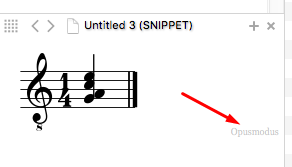
Sometimes it can be useful.
Best,
Julio
-
Thanks ! Best !
-
Dear All,
Simple question
How to make this kind of tuplet ?
(4h. 4h. 4h. 4h.) won´t work in this context...
Best !
Julio

-
Dear Janusz,
Thanks for the explanation.
I found my way to use it !!!
Finally !!!
It will be VERY USEFUL (thanks a lot)
Here is my way to use it:
SCORE BEFORE RE-PITCH
;;; BEFORE REPITCH (progn (setf rv1 '((1/8) (1/8 3/4 1/8 1/8 3/4) (1/4) (1/12 1/12 1/12 3/16 1/4 1/16 -3/8 1/8 1/4 -1/8 1/8) (3/4) (1/8 1/8 1/2 1/4 1/12 1/12 1/12) (3/16) (1/4 1/16 -3/8 1/8 1/4 -1/8 1/8 1/2) (1/4) (1/8 1/2 1/8 1/4 1/12 1/12 1/12 3/16 1/4 1/16) (-3/8 1/8) (1/4 -1/8 1/8 3/4 1/8 1/8) (1/2) (1/4 1/12 1/12 1/12 3/16 1/4 1/16 -3/8 1/8) (1/4) (-1/8 1/8 1/2 1/4 1/8 1/2 1/8) (1/4) (1/12 1/12 1/12 3/16 1/4 1/16 -3/8 1/8 1/4 -1/8 1/8) (3/4) (1/8 1/8 1/2 1/8 3/8) (1/2) (1/8 3/8) (1/8) (1/8 3/4 1/8 1/8 3/4) (1/4) (1/12 1/12 1/12 3/16 1/4 1/16 -3/8 1/8 1/4 -1/8 1/8) (3/4) (1/8 1/8 1/2 1/4 1/12 1/12 1/12) (3/16) (1/4 1/16 -3/8 1/8 1/4 -1/8 1/8 1/2) (1/4) (1/8 1/2 1/8 1/4 1/12 1/12 1/12 3/16 1/4 1/16) (-3/8 1/8) (1/4 -1/8 1/8 3/4 1/8 1/8) (1/2) (1/4 1/12 1/12 1/12 3/16 1/4 1/16 -3/8 1/8) (1/4) (-1/8 1/8 1/2 1/4 1/8 1/2 1/8) (1/4) (1/12 1/12 1/12 3/16 1/4 1/16 -3/8 1/8 1/4 -1/8 1/8) (3/4) (1/8 1/8 1/2 1/8 3/8) (1/2) (1/8 3/8) (1/8) (1/8 3/4 1/8 1/8 3/4) (1/4) (1/12 1/12 1/12 3/16 1/4 1/16 -3/8 1/8 1/4 -1/8 1/8) (3/4) (1/8 1/8 1/2 1/4 1/12 1/12 1/12) (3/16) (1/4 1/16 -3/8 1/8 1/4 -1/8 1/8 1/2) (1/4) (1/8 1/2 1/8 1/4 1/12 1/12 1/12 3/16 1/4 1/16) (-3/8 1/8) (1/4 -1/8 1/8 3/4 1/8 1/8) (1/2) (1/4 1/12 1/12 1/12 3/16 1/4 1/16 -3/8 1/8) (1/4) (-1/8 1/8 1/2 1/4 1/8 1/2 1/8) (1/4) (1/12 1/12 1/12 3/16 1/4 1/16 -3/8 1/8 1/4 -1/8 1/8) (3/4) (1/8 1/8 1/2 1/8 3/8) (1/2) (1/8 3/8))) (setf rv2 '((-1/4 -1/8 1/8) (1/2 -1/4 -1/8 1/8 1/2) (-1/8 1/8) (3/4 -1/2 -1/8 1/8 1/4) (1/12) (1/12 1/12 3/16 1/4 1/16 -1/8 1/8 1/2 -1/8 1/8 1/4) (1/2) (-1/2 -1/8 1/8 1/4 1/12 1/12 1/12 3/16 1/16) (1/4) (-1/8 1/8 1/2 -1/8 1/8 3/4) (-1/2 -1/8 1/8) (1/4 1/12 1/12 1/12 3/16 1/4 1/16 -1/8 1/8) (1/2) (-1/8 1/8 1/4 1/2) (-1/2 -1/8 1/8) (1/4 1/12 1/12 1/12 3/16 1/16 1/4 -1/8 1/8 1/2) (-1/8 1/8) (3/4 -1/2 -1/8 1/8 1/4) (1/12) (1/12 1/12 3/16 1/4 1/16 -1/8 1/8 1/2 -1/4 -1/8 1/8) (1/2) (-1/4 -1/8 1/8) (-1/4 -1/8 1/8) (1/2 -1/4 -1/8 1/8 1/2) (-1/8 1/8) (3/4 -1/2 -1/8 1/8 1/4) (1/12) (1/12 1/12 3/16 1/4 1/16 -1/8 1/8 1/2 -1/8 1/8 1/4) (1/2) (-1/2 -1/8 1/8 1/4 1/12 1/12 1/12 3/16 1/16) (1/4) (-1/8 1/8 1/2 -1/8 1/8 3/4) (-1/2 -1/8 1/8) (1/4 1/12 1/12 1/12 3/16 1/4 1/16 -1/8 1/8) (1/2) (-1/8 1/8 1/4 1/2) (-1/2 -1/8 1/8) (1/4 1/12 1/12 1/12 3/16 1/16 1/4 -1/8 1/8 1/2) (-1/8 1/8) (3/4 -1/2 -1/8 1/8 1/4) (1/12) (1/12 1/12 3/16 1/4 1/16 -1/8 1/8 1/2 -1/4 -1/8 1/8) (1/2) (-1/4 -1/8 1/8) (-1/4 -1/8 1/8) (1/2 -1/4 -1/8 1/8 1/2) (-1/8 1/8) (3/4 -1/2 -1/8 1/8 1/4) (1/12) (1/12 1/12 3/16 1/4 1/16 -1/8 1/8 1/2 -1/8 1/8 1/4) (1/2) (-1/2 -1/8 1/8 1/4 1/12 1/12 1/12 3/16 1/16) (1/4) (-1/8 1/8 1/2 -1/8 1/8 3/4) (-1/2 -1/8 1/8) (1/4 1/12 1/12 1/12 3/16 1/4 1/16 -1/8 1/8) (1/2) (-1/8 1/8 1/4 1/2) (-1/2 -1/8 1/8) (1/4 1/12 1/12 1/12 3/16 1/16 1/4 -1/8 1/8 1/2) (-1/8 1/8) (3/4 -1/2 -1/8 1/8 1/4) (1/12) (1/12 1/12 3/16 1/4 1/16 -1/8 1/8 1/2 -1/4 -1/8 1/8) (1/2) (-1/4 -1/8 1/8))) (setf rv3 '((-1/4 -1/8 1/8) (1/2 -1/4 -1/8 1/8 1/2) (-1/8 1/8) (3/4 -1/2 -1/8 1/8 1/4) (1/12) (1/12 1/12 3/16 1/4 1/16 -1/8 1/8 1/2 -1/8 1/8 1/4) (1/2) (-1/2 -1/8 1/8 1/4 1/12 1/12 1/12 3/16 1/16) (1/4) (-1/8 1/8 1/2 -1/8 1/8 3/4) (-1/2 -1/8 1/8) (1/4 1/12 1/12 1/12 3/16 1/4 1/16 -1/8 1/8) (1/2) (-1/8 1/8 1/4 1/2) (-1/2 -1/8 1/8) (1/4 1/12 1/12 1/12 3/16 1/16 1/4 -1/8 1/8 1/2) (-1/8 1/8) (3/4 -1/2 -1/8 1/8 1/4) (1/12) (1/12 1/12 3/16 1/4 1/16 -1/8 1/8 1/2 -1/4 -1/8 1/8) (1/2) (-1/4 -1/8 1/8) (-1/4 -1/8 1/8) (1/2 -1/4 -1/8 1/8 1/2) (-1/8 1/8) (3/4 -1/2 -1/8 1/8 1/4) (1/12) (1/12 1/12 3/16 1/4 1/16 -1/8 1/8 1/2 -1/8 1/8 1/4) (1/2) (-1/2 -1/8 1/8 1/4 1/12 1/12 1/12 3/16 1/16) (1/4) (-1/8 1/8 1/2 -1/8 1/8 3/4) (-1/2 -1/8 1/8) (1/4 1/12 1/12 1/12 3/16 1/4 1/16 -1/8 1/8) (1/2) (-1/8 1/8 1/4 1/2) (-1/2 -1/8 1/8) (1/4 1/12 1/12 1/12 3/16 1/16 1/4 -1/8 1/8 1/2) (-1/8 1/8) (3/4 -1/2 -1/8 1/8 1/4) (1/12) (1/12 1/12 3/16 1/4 1/16 -1/8 1/8 1/2 -1/4 -1/8 1/8) (1/2) (-1/4 -1/8 1/8) (-1/4 -1/8 1/8) (1/2 -1/4 -1/8 1/8 1/2) (-1/8 1/8) (3/4 -1/2 -1/8 1/8 1/4) (1/12) (1/12 1/12 3/16 1/4 1/16 -1/8 1/8 1/2 -1/8 1/8 1/4) (1/2) (-1/2 -1/8 1/8 1/4 1/12 1/12 1/12 3/16 1/16) (1/4) (-1/8 1/8 1/2 -1/8 1/8 3/4) (-1/2 -1/8 1/8) (1/4 1/12 1/12 1/12 3/16 1/4 1/16 -1/8 1/8) (1/2) (-1/8 1/8 1/4 1/2) (-1/2 -1/8 1/8) (1/4 1/12 1/12 1/12 3/16 1/16 1/4 -1/8 1/8 1/2) (-1/8 1/8) (3/4 -1/2 -1/8 1/8 1/4) (1/12) (1/12 1/12 3/16 1/4 1/16 -1/8 1/8 1/2 -1/4 -1/8 1/8) (1/2) (-1/4 -1/8 1/8))) (setf rv4 '((-1/4 -1/4 -1/8 1/8) (1/4 -1/4 -1/4 -1/8 1/8 1/4) (1/8) (7/8 1/4 1/12 1/12 1/12 3/16 1/16 1/8 1/8) (3/4) (-1/4 -1/8 1/8 1/4 1/8 3/8) (1/2) (1/4 1/12 1/12 1/12 3/16 1/16 1/8 1/2 1/8) (1/4) (-3/8 1/8 1/4 1/8 7/8) (1/4) (1/12 1/12 1/12 3/16 1/16 1/8 1/8 3/4) (-1/4 -1/8 1/8) (1/4 1/8 3/8 1/2 1/4 1/12 1/12 1/12) (3/16) (1/16 1/8 1/2 1/8 1/4 -3/8 1/8 1/4) (1/8) (7/8 1/4 1/12 1/12 1/12 3/16 1/16 1/8 1/8) (3/4) (-1/4 -1/8 1/8 1/4) (-1/4 -1/4 -1/8 1/8) (1/4) (-1/4 -1/4) (-1/4 -1/4 -1/8 1/8) (1/4 -1/4 -1/4 -1/8 1/8 1/4) (1/8) (7/8 1/4 1/12 1/12 1/12 3/16 1/16 1/8 1/8) (3/4) (-1/4 -1/8 1/8 1/4 1/8 3/8) (1/2) (1/4 1/12 1/12 1/12 3/16 1/16 1/8 1/2 1/8) (1/4) (-3/8 1/8 1/4 1/8 7/8) (1/4) (1/12 1/12 1/12 3/16 1/16 1/8 1/8 3/4) (-1/4 -1/8 1/8) (1/4 1/8 3/8 1/2 1/4 1/12 1/12 1/12) (3/16) (1/16 1/8 1/2 1/8 1/4 -3/8 1/8 1/4) (1/8) (7/8 1/4 1/12 1/12 1/12 3/16 1/16 1/8 1/8) (3/4) (-1/4 -1/8 1/8 1/4) (-1/4 -1/4 -1/8 1/8) (1/4) (-1/4 -1/4) (-1/4 -1/4 -1/8 1/8) (1/4 -1/4 -1/4 -1/8 1/8 1/4) (1/8) (7/8 1/4 1/12 1/12 1/12 3/16 1/16 1/8 1/8) (3/4) (-1/4 -1/8 1/8 1/4 1/8 3/8) (1/2) (1/4 1/12 1/12 1/12 3/16 1/16 1/8 1/2 1/8) (1/4) (-3/8 1/8 1/4 1/8 7/8) (1/4) (1/12 1/12 1/12 3/16 1/16 1/8 1/8 3/4) (-1/4 -1/8 1/8) (1/4 1/8 3/8 1/2 1/4 1/12 1/12 1/12) (3/16) (1/16 1/8 1/2 1/8 1/4 -3/8 1/8 1/4) (1/8) (7/8 1/4 1/12 1/12 1/12 3/16 1/16 1/8 1/8) (3/4) (-1/4 -1/8 1/8 1/4) (-1/4 -1/4 -1/8 1/8) (1/4) (-1/4 -1/4))) (setf v1pit '(f5 e5 f5 e5 f5 e5 f5 e5 f5 e5 f5 e5 f5 e5 f5 e5 f5 e5 f5 e5 f5 e5 f5 e5 f5 e5 f5 e5 f5)) (setf v2pit '(c4 d4 c4 d4 c4 d4 c4 d4 c4 d4 c4 d4 c4 d4 c4 d4 c4 d4 c4 d4 c4 d4 c4 d4 c4 d4 c4 d4 c4)) (setf v3pit '(bb3 gs3 bb3 gs3 bb3 gs3 bb3 gs3 bb3 gs3 bb3 gs3 bb3 gs3 bb3 gs3 bb3 gs3 bb3 gs3 bb3 gs3)) (setf v4pit '(bb2 eb2 bb2 eb2 bb2 eb2 bb2 eb2 bb2 eb2 bb2 eb2 bb2 eb2 bb2 eb2 bb2 eb2 bb2 eb2 bb2 eb2)) (setf len-map1 '((e (stacc)) (s (ord)) (h (long)) (h. (long)) (w (long)))) (setf len-map2 '((e (list (rnd-pick '(mf f)))) (s (mf)) (e. (mf)) (h (p<f)) (h. (p<f)) (w (P<f>p))(wq (P<f>p))(wh (P<f>p))(wh. (P<f>p))(ww (P<f>p)))) (setf v1mat-a (make-omn :length rv1 :pitch (span rv1 v1pit) ;to gen-divide = 1 use v1dtc, instead of v1dtb :span :length :velocity (length-map len-map2 rv1 :otherwise '(mf) :repeat t) :articulation (length-map len-map1 rv1 :otherwise '(ord) :repeat t))) (setf v2mat-a (make-omn :length rv2 :pitch (span rv2 v2pit) :span :length :velocity (length-map len-map2 rv2 :otherwise '(mf) :repeat t) :articulation (length-map len-map1 rv2 :otherwise '(ord) :repeat t))) (setf v3mat-a (make-omn :length rv3 :pitch (span rv3 v3pit) :span :length :velocity (length-map len-map2 rv3 :otherwise '(mf) :repeat t) :articulation (length-map len-map1 rv3 :otherwise '(ord) :repeat t))) (setf v4mat-a (make-omn :length rv4 :pitch (span rv4 v4pit) :span :length :velocity (length-map len-map2 rv4 :otherwise '(mf) :repeat t) :articulation (length-map len-map1 rv4 :otherwise '(ord) :repeat t))) (ps 'gm :sq (list (pitch-transpose 0 (ambitus 'violin v1mat-a )) (pitch-transpose 0 (ambitus 'violin v2mat-a)) (pitch-transpose 0 (ambitus 'viola v3mat-a)) (pitch-transpose 0 (ambitus 'cello v4mat-a)) ) :key-signature 'atonal :time-signature '(4 4) ;:tempo 90 :flexible-clef nil :title "Quartet BEFORE RE-PITCH - JULIO HERRLEIN" :display :window) )
My solution is to use one distribute-stream per voice.
In this way, I can just put exactly what I want in each voice.
;;; QUARTET AFTER REPITCH PROCESS USING One instance of Distribute-Stream for each voice (progn (setf repitch1 '(f5 e5 d5 c5 f5 e5 d5 c5 f5 e5 d5 c5 f5 e5 d5 c5 f5 e5)) (setf repitch2 '(c4 cs4 d4 eb4 e4 f4 fs4 g4 gs4 a4 bb4 c5 cs5 d5 eb5 e5)) (setf repitch3 '(c4 b3 bb3 a3 gs3 g3 fs3 f3 e3 eb3 d3 cs3 c3 b2 bb2 a2)) (setf repitch4 '(cs2 g2 cs2 g2 cs2 g2 cs2 g2 cs2 g2 cs2 g2 cs2 g2 cs2 g2)) (setf v1-new (distribute-stream repitch1 (list v1mat-a))) (setf v2-new (distribute-stream repitch2 (list v2mat-a))) (setf v3-new (distribute-stream repitch3 (list v3mat-a))) (setf v4-new (distribute-stream repitch4 (list v4mat-a))) (setf in1 (make-omn :length v1mat-a :pitch (1~ v1-new))) (setf in2 (make-omn :length v2mat-a :pitch (1~ v2-new))) (setf in3 (make-omn :length v3mat-a :pitch (1~ v3-new))) (setf in4 (make-omn :length v4mat-a :pitch (1~ v4-new))) (ps 'gm :sq (list (pitch-transpose 0 (ambitus 'violin in1)) (pitch-transpose 0 (ambitus 'violin in2)) (pitch-transpose 0 (ambitus 'viola in3)) (pitch-transpose 0 (ambitus 'cello in4)) ) :key-signature 'atonal :time-signature '(4 4) ;:tempo 90 :flexible-clef nil :title "Quartet RE-PITCH - JULIO HERRLEIN" :display :window) )All the best !!
Julio
- Stephane Boussuge and opmo
-
 2
2
-
If the restream function could collect the notes horizontally from the source score and place the same way in the destination score it would be nice.
Below, I suggest using one restream for each voice. It works like a charm.
Another possibility would be having the :harmony keyword in the Counterpoint function working with the exact notes you put, without messing the octaves (side effect of the embedded harmonic path).
So the method for composing would be:
1) Do whatever patterns you like ( don´t think about the notes, just the rhythmic texture of the Counterpoint)
2) Put the notes you like (in the exact octave you want) in the :harmony keyword
3) Let the counterpoint do the span (according with the longest pattern or specify spans for each measure
4) Be happy !!
For my purposes, the counterpoint is still what is "almost there".
Best,
Julio



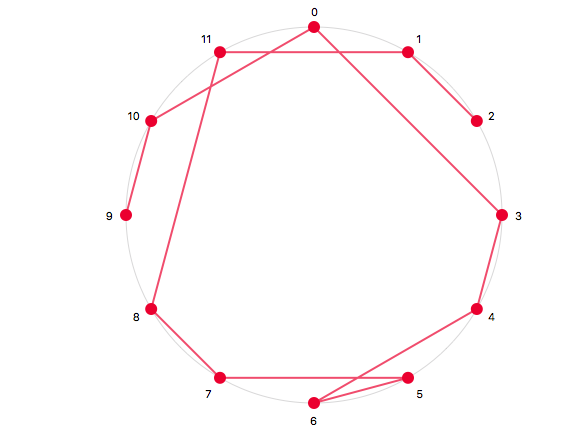
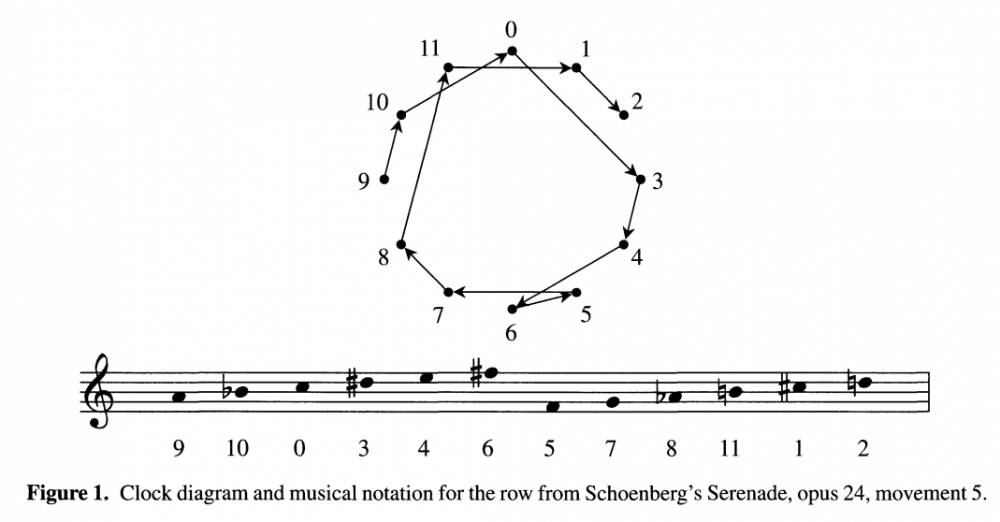
[HERRLEIN] Hauer Tropes as Clockface Diagrams: Dialogs among Forte, Carter and Ŝedivý - MUSMAT 2021
in Made In Opusmodus
Posted
Thanks Janusz and Stephane !
Best !
Julio